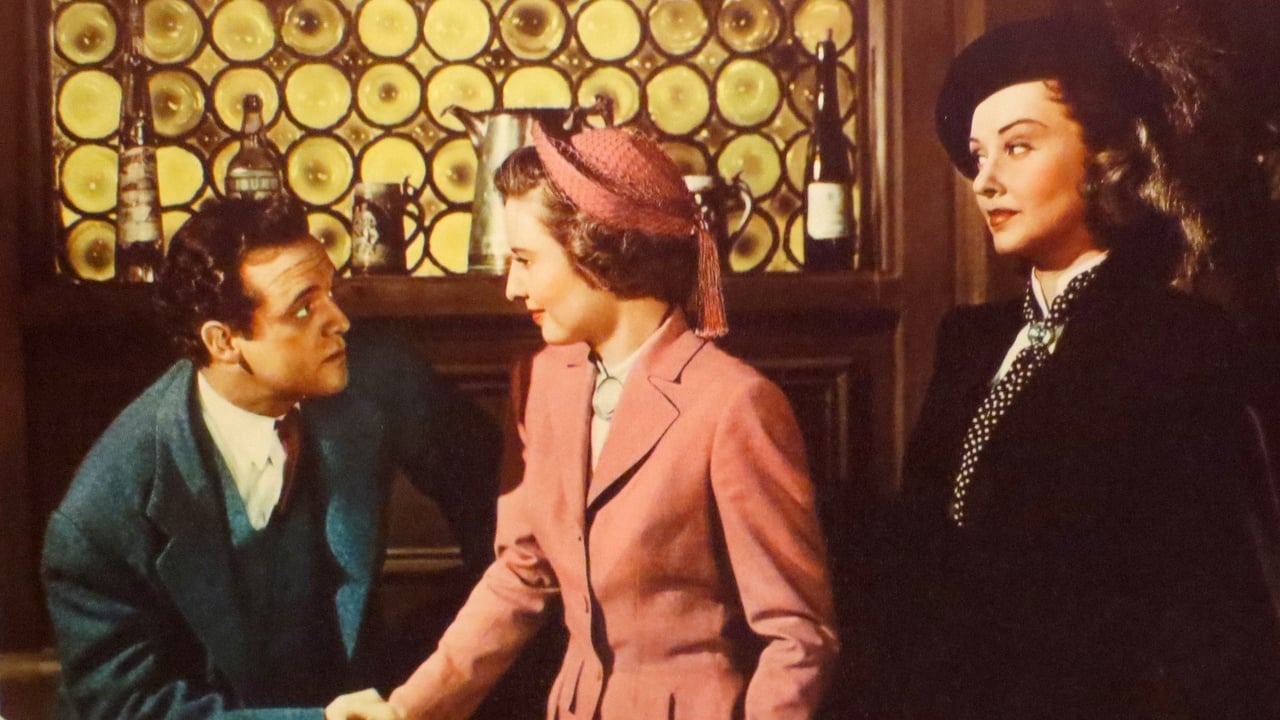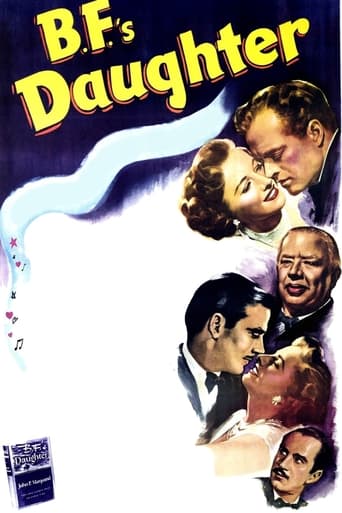

Boring
... View MoreThe tone of this movie is interesting -- the stakes are both dramatic and high, but it's balanced with a lot of fun, tongue and cheek dialogue.
... View MoreThe film never slows down or bores, plunging from one harrowing sequence to the next.
... View MoreI enjoyed watching this film and would recommend other to give it a try , (as I am) but this movie, although enjoyable to watch due to the better than average acting fails to add anything new to its storyline that is all too familiar to these types of movies.
... View MoreCharles Coburn plays the self made man of industry (B.F. Fulton) who has one child, Polly (Barbara Stanwyck), who is not just his daughter but a confidante and even a protégé of sorts about business matters. Meanwhile, B.F.'s wife (Spring Byington) is pretty much wasted here as she spends the entire film knitting.Polly is in love with an attorney, Robert S. Tasmin III, who refuses to marry Polly until he works his way up to assistant partner. Meanwhile, while Bob is up on that corporate ladder, down on the ground Polly meets her friend Apples (Margaret Lindsay) for a drink in a nearby tavern. Educator and lecturer Tom Brett (Van Heflin), zeroes in on Polly and they start talking politics. Polly seems to fall for Tom because of his Bohemian lifestyle and his stylish rudeness that she never encountered in her circles. Within 24 hours they are married. Brett's good buddy is a leftist radio host, Martin Ainsley (Keenan Wynn), who is always talking down rich people in general and B.F. in particular.Yet it is B.F. who comes across as the good guy. He doesn't try to interfere in his daughter's life and seems to genuinely care about his employees. So Polly and Tom start out marriage in a log cabin in Minnesota where Tom is working on his book. Meanwhile, Polly figures - "How can a little financial boost hurt?". She goes to somebody running a nationwide lecture tour and promises to cover his losses if he will hire her husband. Tom knows nothing of this, but once he is out on the circuit his ideas are a big hit. Ultimately, his books and lectures become very profitable and Brett becomes a rich guy too, a member of FDR's brain trust.Will success change Tom Brett? Was Ainsley a phony in the first place? Will Tom and Polly's marriage work out? Watch and find out.I only gave this a six because the adapted screenplay was a bit of a sprawling saga for just under two hours. This film was supposed to be set from the Great Depression years into the midst of WWII, and it was adapted from a novel written in 1946. B.F. and Polly, symbols of the wealthy class, are showcased as the real people here, and Brett and Ainsley ultimately are the stuffy and unbending types with the same character flaws they have been ascribing to the rich.One big negative I would give it - It doesn't try at all to dress people in the clothes of the period. Stanwyck is wearing the same kind of tailored suit that was popular in 1948 at the beginning of the film - which was the early 1930's, and Heflin, who is supposed to be poor, wears a wrinkled suit from the late 1940s himself.The script is a bit of a muddle - it does not follow the novel, especially the last half , but I'd watch it for the acting and for an object lesson in the production code really REALLY trying to make rich people look like misunderstood benefactors, especially just prior to the red scares. It's definitely NOT boring.
... View MoreIn 1932, the Great Depression has most Americans sewing buttons on ragged clothing. Lucky to escape financial ruin is blustery nouveau riche capitalist Charles Coburn (as Burton "B.F." Fulton). His money never stops flowing, which keeps young Park Avenue socialite daughter Barbara Stanwyck (as Pauline "Polly" Fulton) dripping in fur and jewels. Daddy's little girl ditches her attorney boyfriend when she meets apparently poverty-stricken professor Van Heflin (as Thomas "Tom" W. Brett). They have a whirlwind romance and run away to Minnesota, but Ms. Stanwyck's wealth threatens her relationship with Mr. Heflin...This story features some interesting class concepts regarding the rich and the poor. Unfortunately, the characters are obtuse and the story artificial. Stanwyck and Heflin try and cry for director Robert Z. Leonard, but nobody gives "B.F.'s Daughter" any depth...Perversely, the phony costume designs received an "Academy Award" nomination. We are boldly told the story begins in 1932, but Stanwyck is decked out in contemporary fashion. Heflin has a big tear in his vest and Keenan Wynn shows his lowly status with a silly, misshapen hat. There are no real "poor" on screen. Since Heflin is assistant professor of economics at Columbia University and Mr. Wynn's character has his own radio talk show, we can assume they are doing better than most. Romantic entanglements seem barely past an adolescent level. Still, the sets look nice and everything is photographed well, by Joseph Ruttenberg.**** B.F.'s Daughter (3/24/48) Robert Z. Leonard ~ Barbara Stanwyck, Van Heflin, Charles Coburn, Keenan Wynn
... View MoreViewers will recognize Charles Coburn from Gentlemen Prefer Blonds & Monkey Business. Here he plays Burton Fulton, successful businessman, father to Polly (Barbara Stanwyck). Co-stars Van Heflin, Keenan Wynn, and Spring Byington round out the familiar faces in "BF's Daughter". Polly falls for Tom Brett (Heflin) and they talk about "eating in speak-easys" and "the depression", but this was made in 1948, and it sure looks like 1948 throughout. This was written by John Marquand, who had also written some of the Mr. Moto books. The film feels a lot like the Magnificent Ambersons, which had come out six years before -- story of a rich family, and how the offspring deals with changing times. Very serious storyline... the only humor is the ongoing joke of repeatedly calling one of the locals by the wrong name. When Polly tries to help Tom with his career, things don't work out as she wanted. Stanwyck also made "Sorry Wrong Number" right after this in 1948 - THAT role got her nominated for an Oscar... but not THIS one. The script needs some spicing up, or something. Everything and everyone is technically competent, but there's something lacking.
... View MoreThis film is based on a best-selling 1946 novel by John P. Marquand, which satirized a number of aspects of American society between 1932 and 1946, among them liberal and conservative views, the discrepancy between the wealthy and the ordinary folk, and lesser items like radio commentators who didn't know much but didn't let that stop them from sounding off, overbearing Pentagon brass, marriages made on the rebound and so on. However, you'll find precious little of the satire in this film version. MGM turned Marquand's novel into a "women's picture" that enforces what were considered in the late 40s to be the proper roles a man and woman should perform.The plot deals with Polly Fulton, the adventurous daughter of a wealthy industrialist, who decides she doesn't want to marry the stuffed shirt she's engaged to, though he's a decent enough chap. Instead, she will marry a man with ideas, someone a bit off the beaten paths she knows: an assistant professor of economics at Columbia University. (Live dangerously. Ha!) In this limited space, I can't detail much plot beyond indicating that the financial discrepancy between the wife and the husband lead to problems that bring them to the brink of divorce. One point the film is enforcing is that women should not emasculate their husbands by providing financial aid to them. "Hubby" should be the bread winner, even if the wife is wealthy.Before Polly's father dies, he asks her if she's happy in her marriage. She admits that she is not. Now B.F. tells her, "Marriage is an investment. It's like a business. Fight for your marriage." Polly's best friend tells her, "Lots of marriages aren't the way they say they are in books. But they are worth fighting for." So much for this film's philosophy. At the film's conclusion, when Polly's husband is about to leave her, she runs after him, shouting, "Oh, Tom. Don't go! I need you!" With that Tom enfolds her in his arms and says, "Oh, Polly, that's all I've been waiting to hear" and kisses her. Marriage saved. Does this sound like something you want to see today?In the novel, Tom had had an affair, and the marriage was not saved. But this film version is so gutless that it doesn't even allow Tom the affair. Instead, the woman Tom is rumored to be keeping turns out to be an escapee from a concentration camp for whom Tom is acting as a Good Samaritan.In addition, Tom takes back a good many things he'd said earlier in the film, telling Polly he was wrong about her wealthy father, wrong about Robert Tasmin, the Ivy-League educated lawyer Polly was about to marry, calling him "a real gentleman, after all." The movie simply affirms upper-middle-class values and, in fact, makes it clear that it's better to be wealthy, even if that might have some negative effects on a marriage at first. I mean, only animal-rights activists are going to forsake those full-length mink coats that Stanwyck sports here, and some of them might even prove weak when put to the test.The film has fine production values, though there is absolutely no sense of period detail. Everything is happening in 1948 fashions, and although the film covers fifteen years, no one ages a whit.Stanwyck and Van Heflin are clearly too old to play the young Polly and Tom, but, once the two are married, they immediately become 40-somethings for the rest of the film. Stanwyck, Van Heflin, and the rest of the cast all do competent acting jobs. It's just that the script is so weak. Utter piffle!
... View More